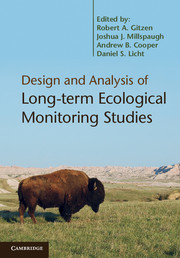Book contents
- Frontmatter
- Contents
- List of contributors
- Foreword: Ecology, management, and monitoring
- Preface
- Acknowledgments
- Abbreviations
- Section I Overview
- Section II Survey design
- Section III Data analysis
- Section IV Advanced issues and applications
- 16 GRTS and graphs
- 17 Incorporating predicted species distribution in adaptive and conventional sampling designs
- 18 Study design and analysis options for demographic and species occurrence dynamics
- 19 Dealing with incomplete and variable detectability in multi-year, multi-site monitoring of ecological populations
- 20 Optimal spatio-temporal monitoring designs for characterizing population trends
- 21 Use of citizen-science monitoring for pattern discovery and biological inference
- Section V Conclusion
- References
- Index
- Plate Section
16 - GRTS and graphs
Monitoring natural resources in urban landscapes
Published online by Cambridge University Press: 05 July 2012
- Frontmatter
- Contents
- List of contributors
- Foreword: Ecology, management, and monitoring
- Preface
- Acknowledgments
- Abbreviations
- Section I Overview
- Section II Survey design
- Section III Data analysis
- Section IV Advanced issues and applications
- 16 GRTS and graphs
- 17 Incorporating predicted species distribution in adaptive and conventional sampling designs
- 18 Study design and analysis options for demographic and species occurrence dynamics
- 19 Dealing with incomplete and variable detectability in multi-year, multi-site monitoring of ecological populations
- 20 Optimal spatio-temporal monitoring designs for characterizing population trends
- 21 Use of citizen-science monitoring for pattern discovery and biological inference
- Section V Conclusion
- References
- Index
- Plate Section
Summary
Introduction
Environmental monitoring programs are an important tool for providing land managers with a scientific basis for management decisions. However, many ecological processes operate on spatial scales that transcend management boundaries (Schonewald-Cox 1988). For example, adjacent lands may influence protected-area resources via edge effects, source-sink dynamics, or invasion processes (Jones et al. 2009). Hydrologic alterations outside management units also may have profound effects on the integrity of resources being managed (Pringle 2000). The impacts of climate change are presenting challenges to resource management at local-to-global scales (Karl et al. 2009). This potential disparity between ecological and political boundaries presents an interesting dilemma for natural resource monitoring and is readily apparent in urban and agricultural environments, which tend to be dominated by external stressors (Collins et al. 2000). Despite their limited control over external land use, natural resource managers are concerned with processes such as development in the surrounding landscape, as these may lead to habitat loss and degradation that directly impair their resources. As a consequence, the management of the natural resources in and around parks and other areas requires a broad and dynamic understanding of the spatio-temporal patterns of environmental change. If monitoring is to be successful in providing data that inform management, information about regional and landscape context should play a critical role in designing monitoring strategies.
Urban parks provide a useful example of the influence of external stressors on managed resources. These parks tend to be small in area and tend not to encompass complete ecological units (e.g. watersheds or ecosystems; Forsyth and Musacchio 2005), conditions that could pose significant challenges to natural resource monitoring (Shafer 1995). Despite these challenges, or perhaps because of them, the conservation value of protected areas in urban environments has been increasingly acknowledged (Niemela 1999, Miller and Hobbs 2002, Lookingbill et al. 2007), and the significance of urban parks as biological refuges will likely increase as urbanization results in continued land conversion of adjacent habitats.
- Type
- Chapter
- Information
- Design and Analysis of Long-term Ecological Monitoring Studies , pp. 361 - 380Publisher: Cambridge University PressPrint publication year: 2012
- 2
- Cited by

